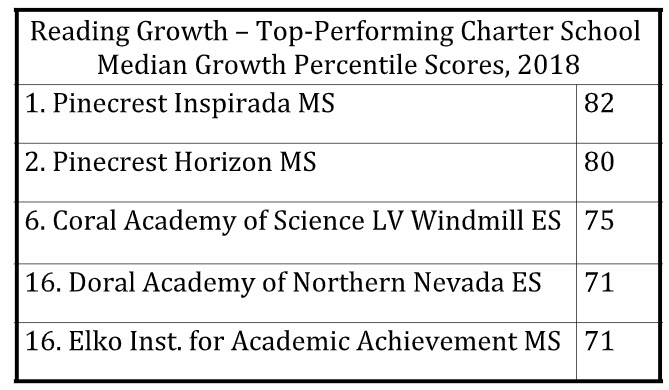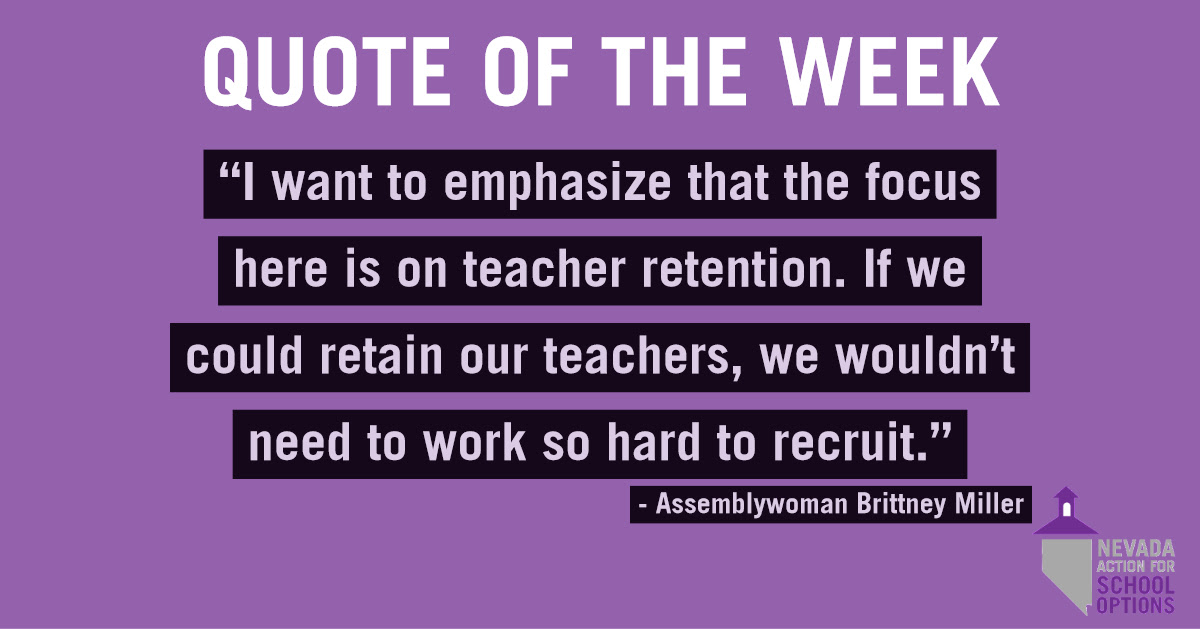Charter Schools Leading the Way on Student Growth Measures
The academic performance of Nevada’s public charter schools have been a prominent subject of discussion in legislative oversight proceedings in the current session and the interim leading up to it. When viewed through one crucial lens, the academic growth of individual students over time, Nevada’s charters demonstrate that they have much to offer the students they serve.
Growth measures are much less impacted by many risk factors in students’ lives which adversely impact proficiency levels, so they can be seen as more equitable measures of school effectiveness.
While there is no single factor that can define what makes a school a high-quality school, this growth measure must be considered among the most important. Accordingly, it is the highest-weighted indicator in Nevada’s School Performance Framework at the elementary and middle school levels (growth is not included in Nevada’s measure of high school performance).
Simply put, Nevada measures growth by comparing how students score on the official state test, the Smarter Balanced Assessment, compared with other students who had the same score on last year’s test in English Language Arts and math.
So how do charters perform when it comes to this growth measure? The top two schools in the state on reading in 2018 were both charter schools – Pinecrest Academies’ Inspirada campus middle school was the top-rated public school in the state for growth in English Language Arts, with a score of 82, followed closely by the second-highest rated school, Pinecrest’s Horizon Middle School, with a score of 80.
“A culture of high expectations and data-driven instruction is what propelled us to have some of the highest English Language Arts growth in the state,” explains Pinecrest Horizon Principal Wendy Shirey. “At the Pinecrest Horizon campus, it was a yearlong effort to improve our scores over the prior year’s results. The ELA teachers were strong in their content, tutored before and after school, and taught intervention classes to help students catch up to grade level. We followed a strong instructional model and a rigorous core curriculum to provide grade level content. In addition to that, we were bold enough to believe we would succeed, and we taught our students to believe this as well. We are very proud of our students and our teachers for this incredible growth. “
Reading Growth – Top-Performing Charter School
MGP Scores, 2018
| 1. Pinecrest Inspirada MS | 82 |
| 2. Pinecrest Horizon MS | 80 |
| 6. Coral Academy of Science LV Windmill ES | 75 |
| 16. Doral Academy of Northern Nevada ES | 71 |
| 16. Elko Inst. for Academic Achievement MS | 71 |
Math Growth – Top-Performing Charter School
MGP Scores, 2018
| 4. Democracy Prep Agassi Campus MS | 82 |
| 5. Discovery Hillpointe MS | 86 |
| 6. Discovery Mesa Vista MS | 81 |
| 14. High Desert Montessori MS | 75.5 |
| 18. Mater Academy Mountain Vista MS | 74 |
| 18. Disovery Hillpointe ES | 74 |
| 18. Elko Inst. for Academic Achievement MS | 74 |
In total, seven of the top 25 schools in the state on reading growth are charter schools, and 12 of the top 50.
Nevada’s public charter schools comprise 11 percent of all campuses statewide, because the Nevada Department of Education generally separates school “campuses” by grade level served for accountability purposes.
Results for charter school students’ growth in math were similarly compelling. Democracy Prep – Agassi Campus was the fourth-highest performing school in the state in student growth in math with a score of 86. This fact is particularly impressive when considering that three out of four students at the campus qualify for the federal Free or Reduced Lunch program.
Immediately following were two charter middle schools, Discovery Hillpointe Middle School and Discovery Mesa Vista Middle School, the 5th and 6th top performing public schools in Nevada as measured by student growth in math.
Not only did charter schools hold three of Nevada’s top six spots in math, but they held seven of the top 25, and 10 of the top 50 (again, Nevada charter schools comprised only 11 percent of campuses measured).
Student performance in math, especially at the middle school grades, has been a particular challenge for Nevada public schools. So schools like Democracy Prep and Mater Academy’s Mountain Vista campus deserve particular recognition for accomplishing such remarkable student growth outcomes while serving a majority of students from lower-income households.
Two takeaways here make sense to support strengthened academic growth:
First, while these charters present valuable examples, their success is uneven across Nevada’s charter school community, and across Nevada public schools generally. Charters where longitudinal student growth consistently earn scores well below 50 points in either English Language Arts or Math need to address these instructional challenges as programmatic weaknesses, and create and implement strategies to improve this performance, as necessary consequentially as part of the charter authorizing process applying to results on the Nevada School Performance Framework.
Second, as Nevada education leaders consider collaboration opportunities between all schools, Nevada’s charter school exemplars have much to offer. Substantive engagement around strategies that contribute to students’ longitudinal growth would be an excellent place to start.






